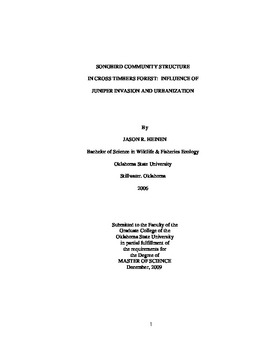| dc.contributor.advisor | O'Connell, Timothy J. | |
| dc.contributor.author | Heinen, Jason | |
| dc.date.accessioned | 2014-04-15T21:59:45Z | |
| dc.date.available | 2014-04-15T21:59:45Z | |
| dc.date.issued | 2009-12-01 | |
| dc.identifier.uri | https://hdl.handle.net/11244/9174 | |
| dc.description.abstract | Several species of North American songbirds with population centers in the eastern U.S. reach the southwestern limit of their breeding range in Oklahoma cross timbers forest. Historically, the cross timbers was dominated by post oak ( Quercus stellata ) and blackjack oak ( Q. marilandica ), but increasingly, these patches are influenced by eastern redcedar ( Juniperus virginiana ) encroachment, as well as urbanization. We investigated the influence of eastern redcedar and urbanization on both breeding and over-wintering songbird communities. During the breeding season (May-July) and peak of winter (Dec-Feb) in 2007-`08 and 2008-`09, we surveyed 7 cross timbers forest patches in Payne County, Oklahoma. The study plots within these patches represented a gradient of condition from low to high prevalence of redcedar. In addition, we established survey plots (n=28) along a gradient of urbanization (as defined by the proportion of impervious surfaces) within Stillwater city limits and conducted surveys of these plots during May-July of 2008. We used repeated samples of a modified spot-mapping approach during breeding surveys, and a modified area search method during winter surveys. During May-June of 2007 and 2008, I found at least 35 species of landbirds (songbirds, woodpeckers, cuckoos, doves, etc.) breeding in cross timbers forest in the study area and at least 33 landbird species, or 77% of the hypothetical species pool during winter. The breeding bird assemblage included approximately 12 species (34% of total) that reach a western limit of their global breeding range in the cross timbers, of which 9 were Neotropical migrants. Species richness (R=0.140, P<0.008) and proportion of Neotropical migrants (R=0.241, P<0.001) were both higher among plots with low cedar encroachment than those with heavy encroachment. In winter, neither species richness (R=0.213, P=0.297) nor Shannon diversity indices (R=0.138, P=0.411) were significantly correlated with cedar cover. Analysis of variance for species' mean territories/plot in 3 categories of % impervious surface yielded significant (P<0.05) differences between groups in over 40% of species. Analysis of variance for species' mean territories/plot in 3 categories of % canopy cover yielded significant (P<0.05) differences between groups in over 45% of species. | |
| dc.format | application/pdf | |
| dc.language | en_US | |
| dc.publisher | Oklahoma State University | |
| dc.rights | Copyright is held by the author who has granted the Oklahoma State University Library the non-exclusive right to share this material in its institutional repository. Contact Digital Library Services at lib-dls@okstate.edu or 405-744-9161 for the permission policy on the use, reproduction or distribution of this material. | |
| dc.title | Songbird Community Structure in Cross Timbers Forest: Influence of Juniper Invasion and Urbanization | |
| dc.type | text | |
| dc.contributor.committeeMember | Fuhlendorf, Samuel D. | |
| dc.contributor.committeeMember | Will, Rodney E. | |
| osu.filename | Heinen_okstate_0664M_10666.pdf | |
| osu.college | Agricultural Sciences and Natural Resources | |
| osu.accesstype | Open Access | |
| dc.description.department | Department of Natural Resource Ecology and Management | |
| dc.type.genre | Thesis | |
| dc.subject.keywords | cedar | |
| dc.subject.keywords | cross timbers | |
| dc.subject.keywords | encroachment | |
| dc.subject.keywords | juniper | |
| dc.subject.keywords | songbird | |
| dc.subject.keywords | urban | |
